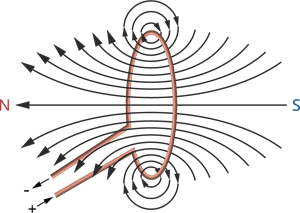PDF chapter test TRY NOW
In the previous sessions, we observed the pattern of the magnetic field lines produced around a current-carrying straight wire.
Suppose this straight wire is bent in the form of a circular loop, and a current is passed through it,
How would the magnetic field lines look like?
We know that the magnetic field created by a current-carrying straight wire depends inversely on the distance from it.
Suppose this straight wire is bent in the form of a circular loop, and a current is passed through it,
How would the magnetic field lines look like?
We know that the magnetic field created by a current-carrying straight wire depends inversely on the distance from it.
Likewise, at every point of a current-carrying circular loop, the concentric circles representing the magnetic field around it would become larger and larger as we move away from the wire (as shown in the below figure).

Magnetic field lines of the field produced by a current-carrying circular loop
By the time we reach the centre of the circular loop, the arcs of these big circles would appear as straight lines.
Every point on the wire carrying current would give rise to the magnetic field appearing as straight lines at the centre of the loop.
Applying the right-hand rule makes it easy to check that every wire section contributes to the magnetic field lines in the same direction within the loop.
We know that the magnetic field created by a current-carrying wire at a particular point depends directly on the current passing through it. Therefore, if a circular coil has 'n' turns, the field created is 'n' times as large as that point (p) created by a single turn. This is because the current in every circular turn has the same direction. Simultaneously, the field due to each turn adds up.
